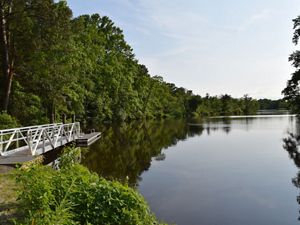Together, nature preserves protect the landscape’s collective biodiversity.
Shared by portions of Delaware and New Jersey, the 3,420 square-mile Delaware Bayshores harbors some of the largest concentrations of interesting habitats, and rare plants and animals, on the East Coast. More than 100 species of migratory and nesting birds visit portions of this landscape throughout the year, including waterfowl, raptors, shorebirds and songbirds traveling from as far away as South America to destinations in the Canadian Arctic.
Forested wetlands grace both sides of the bay, and represent the northernmost part of the range for green treefrogs. Numerous species of rare plants also thrive in the Delaware Bayshores, including swamp pink and sensitive joint-vetch. Most of the world’s remaining population of seaside alder can be found on the Delmarva Peninsula, making the conservation of this species a high priority in Delaware.
Unlike much of the North Atlantic Coast, the Delaware Bayshores remain relatively intact. However, residential development, climate change, overfishing, and invasive species have been causing increasing amounts of stress to this landscape. Water quality also suffers from increased sedimentation and paving that comes with development.
Protecting What Remains
For many years, the Conservancy has worked at individual places throughout the Delaware Bayshores in hopes of capturing and conserving the landscape’s collective biological diversity. At Great Marsh, near Lewes, the Conservancy worked with three neighboring families to establish and protect a 600-acre preserve providing high quality habitat for a wide variety of species, including black duck, teal, osprey, blue crab and fiddler crab. At the nearby 1,364-acre Pemberton Forest Preserve, the Conservancy safeguards Atlantic white cedar swamp forest near the confluence of the Brittingham and Pemberton branches, tributaries of the Broadkill River. The 143-acre Edward H. McCabe Preserve contains a variety of important coastal plain habitats and populations of seaside alder, including more than one mile of river frontage on the Broadkill River.
Farther north, in Eastern Kent County, the Milford Neck Preserve represents the portion of undeveloped beaches and dunes, tidal marshlands, swamp and upland forests where more than a million migratory shorebirds arrive each spring to feed on eggs laid by horseshoe crabs converging on Delaware Bay beaches. Also in Kent County, tidal saltmarshes and mudflats contained within the 341-acre Port Mahon Preserve provide a sanctuary for numerous species of geese, duck, fish and amphibians. In the Blackbird Millington Corridor, the Conservancy has worked closely with local landowners, conservation partners and the business community to find common goals that will preserve the area’s natural heritage and rural character.
Preparing For the Future
With climate change becoming a reality, and increasing population and development across the region, the Conservancy has realized that conserving the Delaware Bayshores in the long-term will require reaching beyond the current project area. That’s why the Delaware Chapter, along with colleagues in Pennsylvania, New Jersey and New York, is evaluating the entire Delaware Bay and Basin as part of a multi-state effort dedicated to conserving “integrated landscapes”—areas having an impact on global conservation and in need of collective attention.
As one of twelve integrated landscapes identified within the Conservancy’s U.S. Conservation region, the Delaware Bay and Basin serves as the focus for staff members from four state programs convening to identify conservation targets, refine strategies, and discuss research and management tools required to conserve this watershed spanning from the Delaware River’s headwaters near Hancock, New York, to the Delaware Bay. This effort involves connecting with partners in places like Brazil and Argentina, where migratory birds spend much of their life cycle. Resources will also be directed toward the Delaware River. As the longest undammed mainstem river east of the Mississippi, the Delaware represents an important migratory pathway and spawning area for several species of diadromous fish such as the American eel, American shad, Atlantic sturgeon and shortnose sturgeon.
Focusing on “integrated landscapes” makes sense. Conserving entire forests, watersheds or marine ecosystems—regardless of their political boundaries—makes the most of limited human and financial resources, and makes these landscapes more resilient to broader issues like climate change, and overfishing. Stay tuned as we move forward on these efforts to conserve one of Delaware’s most treasured landscapes!



_Steven_Billups_4000x2200.jpg?crop=533%2C0%2C2933%2C2200&wid=300&hei=225&scl=9.777777777777779)